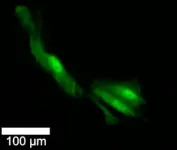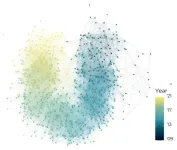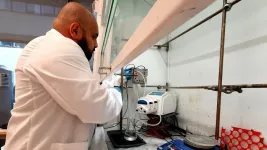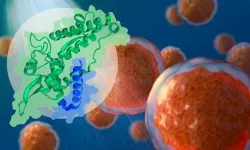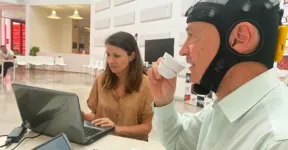(Press-News.org) The high-tech double-barrel nanopipette, developed by University of Leeds scientists, and applied to the global medical challenge of cancer, has - for the first time - enabled researchers to see how individual living cancer cells react to treatment and change over time – providing vital understanding that could help doctors develop more effective cancer medication.
The tool has two nanoscopic needles, meaning it can simultaneously inject and extract a sample from the same cell, expanding its potential uses. And the platform’s high level of semi-automation has sped up the process dramatically, enabling scientists to extract data from many more individual cells, with far greater accuracy and efficiency than previously possible, the study shows.
Currently, techniques for studying single cells usually destroy them, meaning a cell can be studied either before treatment, or after.
This device can take a “biopsy” of a living cell repeatedly during exposure to cancer treatment, sampling tiny extracts of its contents without killing it, enabling scientists to observe its reaction over time.
During the study, the multi-disciplinary team, featuring biologists and engineers, tested cancer cells’ resistance to chemotherapy and radiotherapy using glioblastoma (GBM) - the deadliest form of brain tumour - as a test case, because of its ability to adapt to treatment and survive.
Their findings are published today (7pm GMT/2pm ET, Wednesday, March 6) in the journal Science Advances.
Significant breakthrough
One of the paper’s corresponding authors, Dr Lucy Stead, Associate Professor of Brain Cancer Biology in the University of Leeds’ School of Medicine, said: “This is a significant breakthrough. It is the first time that we have a technology where we can actually monitor the changes taking place after treatment, rather than just assume them.
“This type of technology is going to provide a layer of understanding that we have simply never had before. And that new understanding and insight will lead to new weapons in our armoury against all types of cancer.”
She added: “GBM is the cancer in most need of those new weapons because in 20 years there has been no improvement in survival in this disease.
“It is lagging behind so much and we think that is because of the highly ‘plastic’ nature of these tumours – their ability to adapt to treatment and survive it.
“That is why it is so important that we can dynamically observe and characterise these cells as they change, so we can map out the journey these cells can take, and subsequently find ways to stop them at every turn. We simply couldn’t do that with the technologies that we had.”
Transformative
Dr Stead leads the Glioma Genomics research group at the Leeds Institute of Medical Research at St James's Hospital, which is focused on trying to cure GBM brain tumours. She added: “This technology could be transformative for this particular cancer, helping us finally identify effective treatments for this awful, incurable disease.”
The research was primarily funded by The Brain Tumour Charity, which counts former Leeds footballer Dominic Matteo as one of its high-profile supporters. Matteo did not have GBM but underwent surgery to remove a brain tumour in 2019.
Dr Simon Newman, Chief Scientific Officer at The Brain Tumour Charity, said: “We know glioblastoma cells respond differently to treatment, often developing treatment resistance which leads to recurrence. The development of this novel technology, which can extract samples from tumour cells grown in the lab before and after treatment, will give a unique insight into how drug resistance may develop and lead to tumours growing back.
“We hope that this important work, funded by The Brain Tumour Charity, will improve our knowledge of these complex brain tumours and allow us to find new, more effective treatments – something so urgently needed for those faced with this devastating disease.”
Collaborative
The study was a collaboration between researchers from Leeds’ Bragg Centre for Materials Research; Leeds’ School of Electronic and Electrical Engineering; Leeds Institute of Medical Research, and the Earlham Institute, Norwich, who studied single GBM cells over a period of 72hrs.
They used the nanosurgical platform, which is far too small to be manipulated by hand. The miniscule needles are precisely controlled by robotic software to manoeuvre them into position, into the cells in the petri dish. The nanopipette’s second needle plays a fundamental role in controlling the equipment.
The device allows scientists to take samples repeatedly, to study the progression of disease in an individual cell. Much research on molecular biology is carried out on populations of cells, giving an average result that ignores the fact that every cell is different.
Some cells die during treatment, but others survive. The key to finding a cure is understanding what allows one cell to survive and what is happening to the ones that die.
Unprecedented precision
Lead author Dr Fabio Marcuccio, Research Associate in the Faculty of Medicine at Imperial College London, who carried out the research while at Leeds, said: “Our device allows the study of the way brain cancer cells adapt to treatment over time, with unprecedented precision. This tool will provide data that could lead to significant improvements in cancer treatment and prognoses.”
He added: “This work is the result of a collaborative effort with my colleagues and co-leads Dr Chalmers Chau, Research Fellow in Bionanotechnology in Leeds’ School of Electronic and Electrical Engineering, and Dr Georgette Tanner, formerly of Leeds, now Bioinformatician at Oxford Nanopore Technologies, whose contributions were fundamental to the experimental design and data analysis. This demonstrates the importance of creating an interdisciplinary team to tackle the biggest challenges of our time.”
Cancer cell plasticity - the ability of cells to change their behaviours - is one of the biggest challenges in cancer treatment as it remains poorly understood. GBM cancer cells are particularly “plastic”: they can adapt very quickly, and this is thought to help them develop resistance to radiotherapy and chemotherapy. Learning how these cells adapt, and subsequently how we can block them, could prevent cancer from recurring, something which almost always happens with GBM.
Camilla Hawkins, an occupational therapist from London, was diagnosed with GBM in August 2022. The 55-year-old said: “Any findings, such as these, that could help inform new treatments, has got to be welcomed. Extended good quality of life is worth living, even where the prognosis is terminal.”
Crucially important
The other corresponding author and co-lead Dr Paolo Actis, Associate Professor of Bio-Nanotechnology in Leeds’ School of Electronic and Electrical Engineering, has been working on the nanobiopsy tool for around 15 years and said its new capabilities, compared to its original scope, provided “remarkable advantages”.
He added: “Cancer cells that are not killed by chemotherapy are the ones that make the cancer grow back and lead to death.
“Our tool can pinpoint these cells and we can now perform biopsies on them so we can specifically study how the ones that survive treatment have changed.
“This is crucially important as the more we can understand how the cells change, the more drugs we can develop to stop them from adapting.”
Dr Stead said further research needed to be carried out, using this technology on many more samples in the lab and in humans, but that it had already yielded hugely valuable information.
Additional funding was provided by UK Research and Innovation and the European Commission.
Case Study (with photos)
Camilla’s Story
Camilla Hawkins was diagnosed with a multi-focal glioblastoma multiforme brain tumour in August 2022.
The occupational therapist, from London, called her GP service for advice after struggling to find the right words in a work meeting.
At first, medics thought she may have suffered a stroke, and after speaking to a trainee GP, who advised she visit her local Emergency Department, she was admitted to a stroke ward. Three weeks of investigations followed, before she learned her diagnosis. Understandably, the news came as a huge shock.
The 55-year-old parkrun enthusiast and volunteer, who ran the London Marathon in support of The Brain Tumour Charity last year, says: “I went overnight from being a fit and active occupational therapist to an inpatient, eventually diagnosed with an incurable brain tumour with a limited life expectancy.
“I had worked in oncology many years ago, and in HIV for over 25 years, so I was aware of the statistics that one in two people will be diagnosed with cancer in their lifetime.
“However, the possibility that I might have a brain tumour had literally not entered my head (no pun intended!) I had even commented to the Stroke Consultant, ‘at least it’s not a brain tumour!’
“This type of tumour is always stage 4, and there is no cure.
“There is so little research for this condition, and the lack of research means that many people – myself included – look to other ways in which we might control our cancer. All sorts of things are suggested as possibilities on patient forums and on the web, but none of these are supported by evidence, so medical professionals cannot comment on them.
“I understand that with a patient cohort all of whom will be terminal, research is going to be challenging, but any findings, such as these, that could help inform new treatments, has got to be welcomed. Extended good quality of life is worth living, even where the prognosis is terminal.”
Further Information
Embargoed: Not for Release Until 2pm U.S. Eastern Time Wednesday, 06 March 2024.
The paper “Single-cell nanobiopsy enables multigenerational longitudinal transcriptomics of cancer cells”
DOI: 10.1126/sciadv.adl0515 will appear in the March 6, 2024, issue of the journal Science Advances, published by AAAS, the science society, the world's largest general scientific society. See https://www.science.org/, and https://www.aaas.org/
More information, including a copy of the paper, can be found online at the Science Advances press package at https://www.eurekalert.org/press/vancepak/
Reporters having difficulty accessing the paper from the press package, please contact vancepak@aaas.org
Email University of Leeds press officer Deb Newman on d.newman@leeds.ac.uk with any further media enquiries, to speak to the researchers, or to request an interview with Camilla.
Funding: This research was funded by The Brain Tumour Charity, with additional funding from UKRI and the European Commission.
University of Leeds
The University of Leeds is one of the largest higher education institutions in the UK, with more than 39,000 students from about 170 different countries. We are renowned globally for the quality of our teaching and research.
We are a values-driven university, and we harness our expertise in research and education to help shape a better future for humanity, working through collaboration to tackle inequalities, achieve societal impact and drive change.
The University is a member of the Russell Group of research-intensive universities, and is a major partner in the Alan Turing, Rosalind Franklin and Royce Institutes www.leeds.ac.uk
Follow University of Leeds or tag us into coverage: Twitter | Facebook | LinkedIn | Instagram
Imperial College London
Imperial College London is a global top ten university with a world-class reputation. Imperial’s 22,000 students and 8,000 staff are working to solve the biggest challenges in science, medicine, engineering and business.
Imperial ranks sixth in the 2024 QS World University Rankings and eighth in the 2024 Times Higher Education World University Rankings. The 2021 Research Excellence Framework (REF) found that it has a greater proportion of world-leading research than any other UK university. It also received a Gold Award in the 2023 Teaching Excellence Framework (TEF). Imperial was named University of the Year in the Daily Mail University Guide 2024, University of the Year for Graduate Employment in The Times and Sunday Times Good University Guide 2024 and awarded a Queen’s Anniversary Prize for its COVID-19 response. https://www.imperial.ac.uk/
Earlham Institute, Norwich
The Earlham Institute is a hub of life science research, training, and innovation focused on understanding the natural world through the lens of genomics. Embracing the full breadth of life on Earth, our scientists specialise in developing and testing the latest tools and approaches needed to decode living systems and make predictions about biology. The Earlham Institute is based within the Norwich Research Park and is one of eight institutes that receive strategic funding from the Biotechnology and Biological Sciences Research Council (BBSRC), part of UKRI, as well as support from other research funders.
The Brain Tumour Charity
The Brain Tumour Charity is the UK’s largest dedicated brain tumour charity, committed to fighting brain tumours on all fronts. It funds pioneering research to increase survival and improve treatment options as well as raise awareness of the symptoms and effects of brain tumours to bring about earlier diagnosis. The Charity also provides support for everyone affected by a diagnosis that they can live as full a life as possible, with the best quality of life. Find out more: https://www.thebraintumourcharity.org/
ENDS
END
Nanosurgical tool could be key to cancer breakthrough
2024-03-06
ELSE PRESS RELEASES FROM THIS DATE:
Genetic mutation in a quarter of all Labradors hard-wires them for obesity
2024-03-06
New research finds around a quarter of Labrador retriever dogs face a double-whammy of feeling hungry all the time and burning fewer calories due to a genetic mutation.
This obesity-driving combination means that dog owners must be particularly strict with feeding and exercising their Labradors to keep them slim.
The mutation is in a gene called POMC, which plays a critical role in hunger and energy use.
Around 25% of Labradors and 66% of flatcoated retriever dogs have the POMC mutation, which researchers previously showed causes increased interest in food ...
MIT scientists use a new type of nanoparticle to make vaccines more powerful
2024-03-06
CAMBRIDGE, MA -- Many vaccines, including vaccines for hepatitis B and whooping cough, consist of fragments of viral or bacterial proteins. These vaccines often include other molecules called adjuvants, which help to boost the immune system’s response to the protein.
Most of these adjuvants consist of aluminum salts or other molecules that provoke a nonspecific immune response. A team of MIT researchers has now shown that a type of nanoparticle called a metal organic framework (MOF) can also provoke a strong immune response, by activating the innate immune system — the body’s first line of defense against ...
A noninvasive treatment for “chemo brain”
2024-03-06
CAMBRIDGE, MA -- Patients undergoing chemotherapy often experience cognitive effects such as memory impairment and difficulty concentrating — a condition commonly known as “chemo brain.”
MIT researchers have now shown that a noninvasive treatment that stimulates gamma frequency brain waves may hold promise for treating chemo brain. In a study of mice, they found that daily exposure to light and sound with a frequency of 40 hertz protected brain cells from chemotherapy-induced damage. The treatment also helped to prevent memory loss and impairment of other ...
Film festivals are becoming more diverse in several ways, new study reports
2024-03-06
A group of Tallinn University researchers has published an innovative study that sheds light on the intricate dynamics of the global film festival circuit, revealing insights into diversity and public value creation within the industry. The research demonstrates that festival programming has become more thematically diverse, and the inclusion of films by women creatives has increased between 2012–2021.
The study “Quantifying the global film festival circuit: Networks, diversity, and public value creation,” published open access in the PLOS ONE journal, provides a comprehensive analysis of over 600 film festivals worldwide, spanning a period ...
New hydrogen producing method is simpler and safer
2024-03-06
Researchers in Sweden unveiled a new concept for producing hydrogen energy more efficiently, splitting water into oxygen and hydrogen without the dangerous risk of mixing the two gases.
Developed at KTH Royal Institute of Technology in Stockholm, the new method decouples the standard electrolysis process for producing hydrogen gas, which splits water molecules by applying an electric current. In contrast with prevailing systems it produces the resulting oxygen and hydrogen gases separately rather than simultaneously in the same cell, where they need to be separated by membrane barriers
That separation eliminates the possibility of the gases mixing with the risk of explosions, says ...
Studying the relationship between cancer-promoting proteins
2024-03-06
By Simonne Griffith-Jones, Predoctoral Fellow, EMBL Grenoble
Researchers from the Bhogaraju Group at EMBL Grenoble have gained new insights into how a cancer-relevant family of proteins bind their targets. The results of the study, published in The EMBO Journal, could potentially help in the development of drugs against certain chemotherapy- and radiotherapy-resistant cancers.
The Melanoma Antigen Gene (MAGE) family consists of more than 40 proteins in humans, most of which are only present in the ...
UTA educating schoolchildren about solar eclipse
2024-03-06
The University of Texas at Arlington has received a grant from the National Science Foundation (NSF) to support educational activities related to the upcoming eclipse.
UTA faculty and graduate students are visiting elementary, middle and high schools in the DFW area in March to give talks to about 4,000 students explaining the natural phenomena occurring during the eclipse and the physics behind it. UTA will also provide special eclipse glasses for students to use to avoid eye damage.
The $50,000 grant will also provide for about 1,500 students to take field trips to the UTA Planetarium, one of the three largest in Texas, to learn ...
Espresso yourself: Wearable tech measures emotional responses to coffee
2024-03-06
Researchers in Italy have introduced a novel approach for assessing the quality of coffee. In a pioneering new study, they have demonstrated the feasibility of using wearable technology to measure the emotional responses of coffee experts during tastings.
Published in SCI’s Journal of the Science of Food and Agriculture, the study provides an innovative solution for reducing judgement biases that can result from traditional and more subjective methods of coffee quality assessment.
Coffee is one of the most popular and widely consumed beverages in the world, ...
What drives ‘drug-induced homicide’ prosecutions in North Carolina?
2024-03-06
A new study finds that prosecutors in North Carolina believe “drug-induced homicide” (DIH) laws are effective at both reducing drug overdoses in a community and curtailing the distribution of illicit drugs. These beliefs are worth noting because there is no evidence to support them, while there is evidence that DIH prosecutions make people in affected communities less likely to call 911 – and may actually increase the number of overdoses in a community.
DIH laws, also called “death by distribution” or “delivery resulting in death” laws, ...
Psychosocial stressors linked to higher inflammation in Black pregnant women
2024-03-06
UNIVERSITY PARK, Pa. — Living in neighborhoods with more white residents and greater lifetime experiences of racial discrimination are linked to increased systemic inflammation during pregnancy among Black women, according to new research led by a team from Penn State. The study, published in the February issue of the journal Brain, Behavior, & Immunity – Health, found that these social-environmental factors were associated with higher levels of a protein that has been connected to chronic stress and an elevated risk of ...


